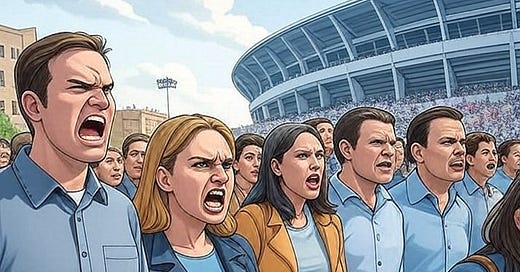In April 2024, Jackson County, Missouri, voters made headlines by rejecting a sales tax to fund a new Kansas City Royals ballpark and upgrades to Arrowhead Stadium, home of the Chiefs. The idea was to keep these beloved teams in town while boosting the local economy. But taxpayers said, “No way.” Why? Let’s break it down in plain language to see if these stadium deals are worth the cost or if team owners are getting a sweet deal at the public’s expense.
The Pitch: Why Build New Stadiums?
Team owners and some local leaders argue that new stadiums bring big benefits. They say stadiums create jobs, attract tourists, and make the city more exciting. In Kansas City, the plan was to use a 3/8th-cent sales tax to raise money for a new Royals stadium in the Crossroads Arts District and to fix up Arrowhead. The promise? More visitors spending money at nearby restaurants, hotels, and shops, plus the pride of keeping the Chiefs and Royals in town. Sounds great, right? But the numbers tell a different story.
The Real Cost to You
Building stadiums isn’t cheap. Across the U.S., taxpayers have shelled out billions—$33 billion since 1970—for sports venues. In Missouri, the proposed tax would’ve lasted 40 years, hitting everyone who shops in Jackson County, especially lower-income folks who feel sales taxes the most. Even though voters rejected the tax, the state is now talking about covering 70% of the costs for new Chiefs and Royals stadiums. That’s money from your taxes that could go to schools, roads, or hospitals instead.
Here’s the kicker: studies show stadiums don’t deliver the economic boost they promise. Research from places like the Brookings Institution says the jobs created are often low-paying, like selling hot dogs or cleaning stands, and only last during the season. The extra spending at games? It’s mostly money people would’ve spent elsewhere in town—at a movie theater or a local diner. In other cities, like Miami, taxpayers paid $200 million for a stadium, only for the team to threaten to leave anyway. Sound fair?
Who Really Wins?
The big winners in these deals are usually the team owners. They get shiny new stadiums that make their teams more valuable. For example, when the Baltimore Orioles’ owner sold the team after getting a publicly funded stadium, he made a 150% profit. Meanwhile, taxpayers are left paying for it, sometimes for decades. In Kansas City, the Chiefs and Royals are worth billions. Their owners could afford to build stadiums themselves, like some teams have done in places like Los Angeles.
Why Missouri Voters Pushed Back
Jackson County voters saw through the hype. They didn’t want to foot the bill for something that mostly benefits wealthy owners and a few local businesses near the stadium. Plus, many believe the Chiefs and Royals won’t actually leave Kansas City—their history and fanbase are too strong. Social media posts on X echo this, calling the teams’ threats to move a bluff to get taxpayers to pay up.
There’s also the question of what else that money could do. For every $147,000 spent on stadium jobs, Missouri could create jobs through other programs for just $6,250 each. Imagine what schools, parks, or healthcare could do with those funds.
The Pride Factor
Sure, having the Chiefs and Royals feels like a big part of Kansas City’s identity. Nobody wants to lose them. But studies show that “civic pride” doesn’t justify the huge costs. In Oklahoma City, a new arena for the Thunder cost taxpayers $900 million. That’s thousands of dollars per adult in the city—would you pay that much to keep a team?
A Better Way?
If Missouri wants new stadiums, there are fairer ways to pay for them. Some cities use taxes on game tickets or luxury suites, so the people who use the stadiums pay the most. Private financing is another option—billion-dollar team owners could take out loans, just like the rest of us do for big purchases.
The Bottom Line
Missouri taxpayers were right to be skeptical. New stadiums sound exciting, but the evidence shows they’re a bad deal for regular people. The jobs and tourism they bring don’t match the massive costs, and the real winners are the team owners. Next time you hear about a stadium plan, ask yourself: who’s really paying, and who’s really profiting? Chances are, it’s not the fans.






